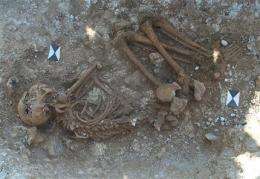Stonehenge skeleton came from Mediterranean

(AP) -- A wealthy young teenager buried near Britain's mysterious Stonehenge monument came from the Mediterranean hundreds of miles away, scientists said Wednesday, proof of the site's importance as a travel destination in prehistoric times.
The teen - dubbed "The Boy with the Amber Necklace" because he was unearthed with a cluster of amber beads around his neck - is one of several sets of foreign remains found around the ancient ring of imposing stones, whose exact purpose remains unknown.
The British Geological Survey's Jane Evans said that the find, radiocarbon dated to 1,550 B.C., "highlights the diversity of people who came to Stonehenge from across Europe," a statement backed by Bournemouth University's Timothy Darvill, a Stonehenge scholar uninvolved with the discovery.
"The find adds considerable weight to the idea that people traveled long distances to visit Stonehenge, which must therefore have had a big reputation as a cult center," Darvill said in an e-mail Wednesday. "Long distance travel was certainly more common at this time than we generally think."
The skeleton, thought to be that of a 14- or 15-year-old, was unearthed about two miles (3 kilometers) southeast of Stonehenge, in southern England.
Clues to the adolescent's foreign origins could be found in the necklace, which isn't a recognized British type. But he was traced to the area around the Mediterranean Sea by a technique known as isotope analysis, which in this case measured the ratio of strontium and oxygen isotopes in his tooth enamel.
Different regions have different mixes of elements in their drinking water, for example, and some of those are absorbed into a person's tooth enamel as he or she grows up. Analysis of the isotopes of oxygen and strontium carried in the enamel can give scientists a good but rather general idea of where a person was raised.
The teen, whose necklace suggests he came from a rich family, is one of several long-distance travelers found near Stonehenge. The "Amesbury Archer," so-called because of the stone arrowheads he was found with, was buried three miles (5 kilometers) from Stonehenge but is thought to have come from the Alpine foothills of central Europe. The "Boscombe Bowmen," also found nearby, are thought to have come from Wales or possibly Brittany.
It isn't clear precisely what drew these people to Stonehenge, a site which has existed in various forms for some 5,000 years. It clearly had an important ceremonial function, and the area around it is dotted with the remains of prehistoric monuments and tombs. Some say it was at the center of a sun-worshipping culture or that it served as a kind of astronomical calendar.
Others, like Darvill, also say it might have been an important healing site, drawing pilgrims from across Europe like a prehistoric version of Lourdes.
More information: Stonehenge: http://www.english-heritage.org.uk/daysout/properties/stonehenge/
©2010 The Associated Press. All rights reserved. This material may not be published, broadcast, rewritten or redistributed.



















